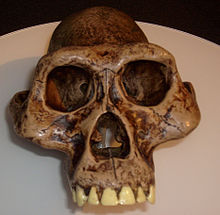ഓസ്ട്രലോപിറ്റെക്കസ്
ഏകദേശം 40 ലക്ഷം വർഷങ്ങൾക്ക് ഭൂമുഖത്ത് നിലനിന്നുരുന്നതും 20 ലക്ഷം വർഷങ്ങൾക്ക് മുമ്പ് വംശനാശം സംഭവിക്കുകയും ചെയ്തതായ മനുഷ്യന്റെ പൂർവ വിഭാഗമാണ് ഓസ്ട്രലോപിറ്റെക്കസ്. [1] ഓസ്ട്രലോപിറ്റെക്കസ് എന്ന വാക്കിനർത്ഥം 'കുരങ്ങൻ', അന്നാണ്. പാലിയന്റോളജിക്കൽ, പുരാവസ്തുശാസ്ത്രപരമായ തെളിവുകൾ എന്നിവയിൽ നിന്നും ഓസ്ട്രലോപിറ്റെക്കസ് ജനുസ്സ് കിഴക്കൻ ആഫ്രിക്കയിൽ ഏകദേശം 4 ദശലക്ഷം വർഷങ്ങൾക്ക് മുമ്പ് പരിണാമം പ്രാപിച്ച് ഭൂഖണ്ഡത്തിലുടനീളം വ്യാപിക്കുകയും ഒടുവിൽ രണ്ട് ദശലക്ഷം വർഷങ്ങൾക്ക് മുമ്പ് വംശനാശം സംഭവിക്കുകയും ചെയ്തു.
| ഓസ്ട്രലോപിറ്റെക്കസ് | |
|---|---|

| |
| Australopithecus afarensis reconstruction, San Diego Museum of Man | |
| ശാസ്ത്രീയ വർഗ്ഗീകരണം | |
| Domain: | Eukaryota |
| കിങ്ഡം: | Animalia |
| Phylum: | കോർഡേറ്റ |
| Class: | Mammalia |
| Order: | Primates |
| Infraorder: | Simiiformes |
| Family: | Hominidae |
| Subfamily: | Homininae |
| Tribe: | Hominini |
| Subtribe: | †Australopithecina |
| Genus: | †Australopithecus R.A. Dart, 1925 |
| Type species | |
| †Australopithecus africanus Dart, 1925
| |
| Subgroups | |
|
Also called Praeanthropus Cladistically included genera (traditionally sometimes excluded): | |
പ്രാധാന്യം
തിരുത്തുകമനുഷ്യ പരിണാമത്തിൽ ഓസ്ട്രലോപിറ്റെക്കസ് സ്പീഷീസിന് വളരെയധികം പ്രാധാന്യം ഉണ്ട്. ഹോമോ എന്ന ജനുസ്സാണ് മൂന്ന് ദശലക്ഷം വർഷങ്ങൾക്ക് മുമ്പ് ഓസ്ട്രലോപിറ്റെക്കസിൽ നിന്ന് ഉത്ഭവിച്ചത്. കൂടാതെ, ചില ജീനുകൾ കൈവശമുള്ള ആദ്യത്തെ ഹോമിനിഡുകളാണ് ഓസ്ട്രലോപിറ്റെക്കസ്. ഇവയുടെ തനിപ്പകർപ്പ് SRGAP2 [2] എന്നറിയപ്പെടുന്നു. [3] തലച്ചോറിലെ ന്യൂറോണുകളുടെ നീളവും കഴിവും മറ്റ് പൂർവ്വ വിഭാഗങ്ങളെക്കാൾ വികസിതമായിരുന്നു ഈ വിഭാഗത്തിന്. ഓസ്ട്രലോപിത്ത് ഇനങ്ങളിലൊന്ന് ഏകദേശം രണ്ട് ദശലക്ഷം വർഷങ്ങൾക്ക് മുമ്പ് ആഫ്രിക്കയിലെ ഹോമോ ജനുസ്സിലേക്ക് പരിണമിച്ചു (ഉദാ. ഹോമോ ഹബിലിസ്). [4]ഒടുവിൽ ആധുനിക മനുഷ്യരായ ഹോമോ സേപിയൻസ് പരിണാമപ്പെട്ടതും ഓസ്ട്രലോപിറ്റെക്കസ് സ്പീഷീസിൽ നിന്നാണ്. [5] [6]
അവലംബം
തിരുത്തുക- ↑ David A. Raichlen; Adam D. Gordon; William E. H. Harcourt-Smith; Adam D. Foster; Wm. Randall Haas Jr (2010). Rosenberg, Karen (ed.). "Laetoli Footprints Preserve Earliest Direct Evidence of Human-Like Bipedal Biomechanics". PLoS ONE. 5 (3): e9769. Bibcode:2010PLoSO...5.9769R. doi:10.1371/journal.pone.0009769. PMC 2842428. PMID 20339543.
{{cite journal}}: CS1 maint: unflagged free DOI (link) - ↑ Reardon, Sara (2012), "The Humanity Switch", New Scientist (AU/NZ), 12 May 2012 No. 2864, pp. 10–11. ISSN 1032-1233
- ↑ Beck, Roger B.; Linda Black; Larry S. Krieger; Phillip C. Naylor; Dahia Ibo Shabaka (1999). World History: Patterns of Interaction. McDougal Littell. ISBN 978-0-395-87274-1.
- ↑ Jones, S.; Martin, R.; Pilbeam, D., eds. (1994). The Cambridge Encyclopedia of Human Evolution. Cambridge: Cambridge University Press. ISBN 978-0-521-32370-3. Also ISBN 0-521-46786-1 (paperback)
- ↑ Toth, Nicholas and Schick, Kathy (2005). "African Origins" in The Human Past: World Prehistory and the Development of Human Societies (Editor: Chris Scarre). London: Thames and Hudson. Page 60. ISBN 0-500-28531-4
- ↑ Bower, Bruce (May 20, 2006). "Hybrid-Driven Evolution: Genomes show complexity of human-chimp split". Science News. 169 (20): 308–309. doi:10.2307/4019102. JSTOR 4019102.